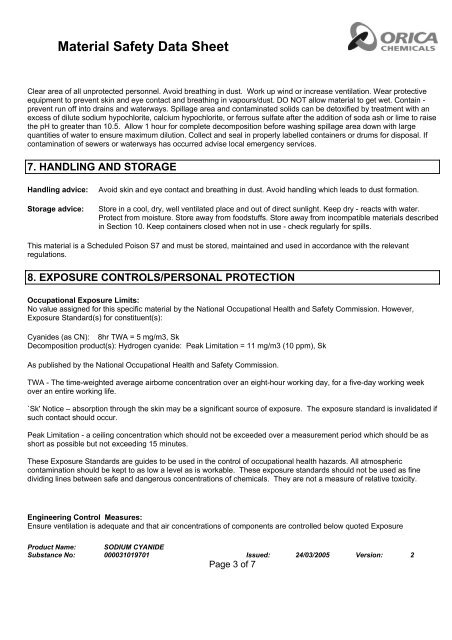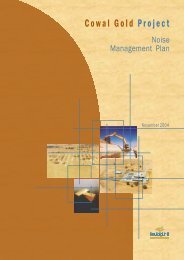January 2006 (PDF 2.9 MB) - Barrick Gold Corporation
January 2006 (PDF 2.9 MB) - Barrick Gold Corporation
January 2006 (PDF 2.9 MB) - Barrick Gold Corporation
Create successful ePaper yourself
Turn your PDF publications into a flip-book with our unique Google optimized e-Paper software.
Material Safety Data Sheet<br />
Clear area of all unprotected personnel. Avoid breathing in dust. Work up wind or increase ventilation. Wear protective<br />
equipment to prevent skin and eye contact and breathing in vapours/dust. DO NOT allow material to get wet. Contain -<br />
prevent run off into drains and waterways. Spillage area and contaminated solids can be detoxified by treatment with an<br />
excess of dilute sodium hypochlorite, calcium hypochlorite, or ferrous sulfate after the addition of soda ash or lime to raise<br />
the pH to greater than 10.5. Allow 1 hour for complete decomposition before washing spillage area down with large<br />
quantities of water to ensure maximum dilution. Collect and seal in properly labelled containers or drums for disposal. If<br />
contamination of sewers or waterways has occurred advise local emergency services.<br />
7. HANDLING AND STORAGE<br />
Handling advice: Avoid skin and eye contact and breathing in dust. Avoid handling which leads to dust formation.<br />
Storage advice: Store in a cool, dry, well ventilated place and out of direct sunlight. Keep dry - reacts with water.<br />
Protect from moisture. Store away from foodstuffs. Store away from incompatible materials described<br />
in Section 10. Keep containers closed when not in use - check regularly for spills.<br />
This material is a Scheduled Poison S7 and must be stored, maintained and used in accordance with the relevant<br />
regulations.<br />
8. EXPOSURE CONTROLS/PERSONAL PROTECTION<br />
Occupational Exposure Limits:<br />
No value assigned for this specific material by the National Occupational Health and Safety Commission. However,<br />
Exposure Standard(s) for constituent(s):<br />
Cyanides (as CN): 8hr TWA = 5 mg/m3, Sk<br />
Decomposition product(s): Hydrogen cyanide: Peak Limitation = 11 mg/m3 (10 ppm), Sk<br />
As published by the National Occupational Health and Safety Commission.<br />
TWA - The time-weighted average airborne concentration over an eight-hour working day, for a five-day working week<br />
over an entire working life.<br />
`Sk' Notice – absorption through the skin may be a significant source of exposure. The exposure standard is invalidated if<br />
such contact should occur.<br />
Peak Limitation - a ceiling concentration which should not be exceeded over a measurement period which should be as<br />
short as possible but not exceeding 15 minutes.<br />
These Exposure Standards are guides to be used in the control of occupational health hazards. All atmospheric<br />
contamination should be kept to as low a level as is workable. These exposure standards should not be used as fine<br />
dividing lines between safe and dangerous concentrations of chemicals. They are not a measure of relative toxicity.<br />
Engineering Control Measures:<br />
Ensure ventilation is adequate and that air concentrations of components are controlled below quoted Exposure<br />
Product Name: SODIUM CYANIDE<br />
Substance No: 000031019701 Issued: 24/03/2005 Version: 2<br />
Page 3 of 7

















